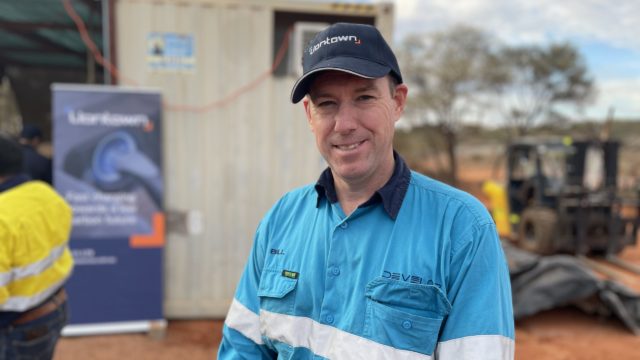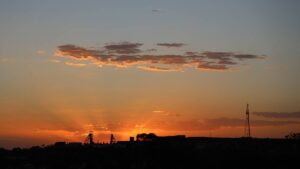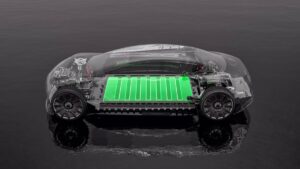Q+A: Aussie mining legend Bill Beament talks stonker copper hits and facing the future

Pic: Josh Chiat/Stockhead
Bill Beament has wasted little time turning his mining contractor Develop Global (ASX:DVP) into a revenue spinner.
Since its relaunch as an underground specialist mining services stock and copper developer at Diggers and Dealers in 2021, Develop has won the contract on the Bellevue (ASX:BGL) gold mine and is looking at $50-60 million in revenue in FY23, ramping up to $125-130m next year.
But its copper and zinc assets stole the show in the former Northern Star (ASX:NST) head honcho’s presentation at the Resources Rising Stars conference on the Gold Coast yesterday.
Its Woodlawn mine in New South Wales, bought from the administrators of Heron Resources in 2022 for $30m, is showing signs it could deliver rich zones of copper and zinc outside its current underground resource of 7.3Mt at 5.7% Zn, 1.8% Cu, 2.0% Pb, 44.9g/t Ag and 0.6g/t Au.
Beament stepped on stage at the Royal Pines Resort armed with what he described as “stonker” copper hits from outside the current resource and Woodlawn’s historic production of 13.8Mt at 15.9% ZnEq.
Drink in the interval of 75m at 2.1% Cu, 3.1% Zn and 8.9g/t Ag in the G lens, part of a maiden 35,000m drill program under Develop’s ownership and a strike that sent the $587m company’s shares running 7.4% higher yesterday.
At prices of US$8273/t copper and US$2532/t zinc respectively, Develop’s main commodities have seen better days in 2023.
But Beament remains extremely positive on their outlook. We sat down with the man after his presentation to talk about that copper hit, and how Develop plans to become a 50,000tpa producer in an Australian investment market crying out for exposure to the red metal.
So tell me a little bit about the hits you released to the market this morning. How does that change the picture for the development of Woodlawn?
“Probably what it does is everything that we’re drilling at the moment is over and above our life of mine model which we’ve pretty much developed at the moment, we’re just obviously looking at funding.
“So it just gives you more and more confidence that this thing’s going to get turned on at a point of time. We’ve still got to present that to the board at mid-year, and yada yada yada. But, you know, that was a stonker hit today, 62m true width at over 3% copper equivalent, and the vast majority of that mineralisation was outside current resources.
“Every asset I’ve bought, and I’m up to 15 mines in 15 years, you always look at the geology first. And if it’s been a great producing mine, high grade X, Y, Z, orebodies don’t change over night. It’s just a factor of drilling information into rinse and repeat.
“So this was the second highest grade zinc equivalent mine in the country for like 20 years behind Rosebery, which is an amazing world class orebody. We were always going to shoot fish in a barrel with that drilling.
“And the interesting part is we only just put the second rig today into the actual purpose built drill drive. The reason we put a kilometre long drive down and put a T-piece on was to put diamond drills.
“These hits we’ve put out in the market last month and today, they’re not even from the purpose built (area) down the bottom of the drill drive. That’s yet to come. Watch this space on that. That’ll be pretty exciting.”
It’s always been sort of a zinc equivalent resource down at Woodlawn. But copper is the market that’s, I guess, running hot from an investment perspective. How do you reframe it in that copper narrative?
“(It’s) a good point, like the first lens we mine they (Heron) found in 2014, even though they mined around it 30 years ago, is the Kate lens which is actually quite copper rich. And we’ve seen that, we’ve already cross-cut four level accesses into the Kate lens and we’ve already got samples back. It’s copper rich, and you can see it, you can’t miss the chalco (chalcopyrite, a copper rich mineral).
“This drilling is really interesting, because the J lens is a copper discovery. And when we put those results out last month, you know, 20-odd metres at 5%. I think it was seven or eight metres at 9% type of thing. So we are seeing these copper rich parts of the lens as well.
“We’re looking at the life of mine at the moment, the way we’ve done our flow sheet, everything, don’t be surprised if it’s more copper revenue than zinc revenue at mid year. That’s where we’re seeing our data. And that’s not even including the hits we’re getting that are really copper rich. So it’s pretty exciting.
“Obviously, copper is probably an easier commodity for people to understand. Even though we need so many bloody wind turbines to transition the world’s energy needs, and they’re all going to be offshore or onshore. I hope they’re offshore because they use a s..tload more zinc.
“But you know, we’re going to need copper and zinc and all that sort of stuff. So, yeah, pretty excited how that’s panning out.”
The broader ambition for the business, you said today, you want to be 50,000 tonnes per annum copper over 7-10 years.
“We want to be in excess of 50. We’ve got to be conservative in our approach with our assets, I think we could probably do a little bit better. And I want to establish long mine lives, you know, that seven to 10-year mine life, you get rewarded for that.
“If you’ve got that underground visibility backed by your statements, your reserves and resources, then people can start valuing you properly. And I think we’ll easily have that on Sulphur Springs, and I think we’ll easily have that on Woodlawn in due course.”
And just about that ambition, why is 50,000 tonnes per annum the target?
“We know our two assets, what the size of the ore bodies (are), we know the tonnages, we know the metal, we know the recovery, so we know where our production profile is going to be. We will give more colour on that in Woodlawn mid-year.
“And then obviously, we’re doing a DFS mid next month. So pretty quickly in the next couple of months, you’re going to understand what our future production profile looks like.”
If you do get that 50,000 tonnes per annum, is that a particular size of company or part of the market that you’re targeting from an investment perspective?
“Well, not necessarily. It’s just there’s not much to choose from. If you want copper exposure on the ASX where do you go now? Oz Minerals just dropped 10 billion bucks into a lot of fund managers in Australia’s pocket and a few offshore. Where do you go? 29Metals? Aeris? Aurelia? Sandfire?
“Sandfire’s an amazing company but now there are not any operations domestic, it’s offshore. So you add in sovereign risk. At the moment it’s the go-to name if you want copper exposure, but the assets aren’t in Australia.
“So for me, there’s a real opportunity with people actually realising that if you want exposure, you’re going to have to start looking at some different names hence why Mick McMullen’s bought Cobar (where Beament is also involved).
“That will definitely be a success story when it dual-lists on the ASX, because you’ve now got a domestic copper producer. And we won’t be too far behind him.”
In terms of the marketing, copper companies produce your concentrate, they sell that to smelters and then they’ve sort of just gone into this giant trading market – Glencore, Trafigura.
“Hidden in the system.”
Yes, so what are you seeing from the customer side? Obviously, OEMs have come in for nickel and lithium, is that going to trickle down into copper and zinc? And does that change the outlook from a revenue perspective for companies like yourselves?
“The world’s changing really quickly in this space of where people want their product from, how they want that, where it comes from, what’s the carbon intensity like. The end user is the energy person building wind turbines, or it is the EV carmakers or people doing the energy solutions.
“They want to know where their product comes from. And it’s really fascinating to watch what’s happening out there because you’re right, with the copper and zinc market, it all gets washed up with a couple of big trading houses and they blend products, all that sort of stuff. So there are some natural things you have to solve there. Like, if you’ve got product A that might need to be blended with product B, but I do think it’s changing really quickly.
“When I went to BMO (conference) last year, there were no car companies at BMO. This year, every single car company had five to 15 reps. It was extraordinary, I met a number of them. And they’re literally like ‘you’re gonna produce copper and zinc, we’ll take it.’
“It’s not that easy, as we know, it’s not that simple. But the car companies are now realising they’ve got to secure raw inputs.
“So it’s going to be fascinating how that plays out, you’ve still got to get through a smelter and refine and all that. So there’s still that element. But I’ll also throw out the question why do you need a trading partner in-between? I think that’s the part that I find is going to change in the coming years.
“Why don’t you go direct to smelters and refiners like do you need a trader? Like really? Like do you? Does someone need to click the ticket, I don’t know.
“Obviously, the Glencores and Trafiguras have got the whole kit and caboodle. But it’s gonna play out in the coming years and it’s fascinating to watch. We’re very lucky because pretty much the vast majority of it, any of the concentrate we produce is unencumbered. We’ve got no offtakes, it’s a super powerful position to be in.”
In what sense?
“Look at the lithium companies that locked in long-term life of mine contracts at s..t prices. And you imagine if they were delivering all into spot how much more money they’d be making. So I’ve been pretty skeptical about some of these people giving away offtakes, I reckon that’s really, really dangerous.
“And I think I don’t see many people that win from it. Because you’re betting against the house and the house normally always wins. So for me, one of our real key selling points is that our copper and our zinc future con other than Sulphur Springs has got … 18 months worth of zinc production, everything else is unencumbered.
“So we’ve just employed a concentrate marketing person, a consultant, going through all that now. So it’s been interesting because we’ve definitely been inundated by companies that want our con because it’s going to be a very green con too.”
Is that a bet on copper and zinc prices going up in the future?
“Look, you can only ever deal in the spot price. So whenever I do valuations of what I’m going to make now or an M & A thing I always use spot price, but it’s fair to say I’m a bull in future facing metals.
“And purely and simply I don’t know where the world’s going to get their supply from because this stuff just doesn’t grow on trees, you’ve got to find it, you’ve got to permit it, you’ve got to build it, you’ve got to get people to operate it, and then spit something out the back end.
“And it’s getting harder and harder to get stuff permitted. So, for me, I’m looking at the demand going, yep, this is all great, everyone wants to transition the world, we’re going to help do that as a company.
“But then I go to the actual reality and talk to any mining company globally and they all just sit there and go, ‘where’s it gonna come from?’
“Where is the supply gonna come from? That part I think is a train crash coming.
“The markets are always short term, as you know, they’re quarter by quarter. But have a look at where the demand kicks in.
“It really is 2025 onwards. Everyone’s committed around the world. Our local government here is committed, my State government back in WA have committed, they’ve all committed their timelines on net zero.
“But how the hell are we gonna get there, that’s the part that I just find fascinating and the commodity markets will work that out in the next year or two when the world normalises, and everyone wants this stuff.
“It ain’t going to be sitting on the shelves.”
Develop Global (ASX:DVP) share price today:

UNLOCK INSIGHTS
Discover the untold stories of emerging ASX stocks.
Daily news and expert analysis, it's free to subscribe.
By proceeding, you confirm you understand that we handle personal information in accordance with our Privacy Policy.








